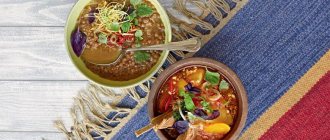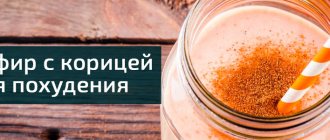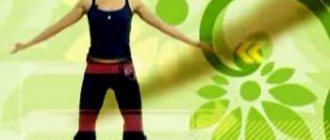Many nutritionists advise losing weight on a bean diet.
Legume products are rich in vegetable fats, minerals and vitamins. In a week on a bean diet you can lose 3 to 5 excess fat. The main thing is not to forget to drink water in sufficient quantities. Legumes contain substances that slow down the accumulation of fat reserves in the body. Since all legumes (peas, soybeans, lentils) have this property. The products are quite varied, so you won’t get bored with the diet. One option is a green pea diet. In the evening, you can drink regular kefir or supplemented with bifidobacteria. This will calm the intestines, reduce the irritating effect of legumes, and improve digestion.
Beneficial properties of beans for weight loss
The legume family includes up to 17 thousand species, including beans, peas, soybeans, lentils, as well as the beans themselves - an annual vegetable crop, one of the most ancient on Earth. Judging by ancient chronicles, the Vicia faba plant has been known in the Middle East for 8 millennia; it was considered the food of the gods and was used to treat many diseases, including obesity. Russian farmers have been cultivating it since the reign of the Rurik princes.
There are about 2 dozen varieties of beans, among them the common European ones: white, green, black, asparagus (cowpeas), as well as the exotic for us snake beans, mung, chickpeas (lamb peas). In terms of composition and benefits for weight loss, they differ slightly; the main advantages are a fairly modest calorie content, a large amount of fiber and proteins. The structure of these proteins is similar to those that make up meat, but unlike meat or fish, vegetables contain almost no fat.
Fiber (dietary fiber) cleanses the intestines, promotes digestion, and also suppresses the feeling of hunger for a long time, which helps control appetite. When using legumes in the treatment of obesity, it was found that the weight of people in whose diet they were included decreases faster than in patients in the control group. Bean seeds contain about 35% protein, so 100-150 g of this product is enough to meet the daily protein requirement.
In addition, the fruits of Vicia faba serve as a source of useful substances necessary to stabilize the functioning of all organs and systems, strengthen the immune system, improve metabolism, useful for weight loss:
- vitamins: A, C, PP, as well as 5 representatives of group B;
- macroelements - potassium, calcium, sodium, magnesium, phosphorus;
- microelements - iron, manganese, copper, selenium, zinc;
- amino acids formed from proteins - arginine, glycine, serine, cysteine, tyrosine, proline;
- essential amino acids - histidine, leucine and isoleucine, methionine, tryptophan, phenylalanine.
A significant advantage of legume diets for weight loss is the combination of high efficiency with easy tolerability - despite the satiety of the diet, the daily calorie content usually does not exceed 1000 Kcal. For this reason, they are often chosen by those who are unable to withstand other, more stringent nutritional methods. Unripe beans are especially useful; they have a richer composition and a more delicate taste.
Attention! There are capsules for weight loss called “Magic Beans”, they are recommended to be taken 2-3 per day. But this drug does not contain legumes; it is made on the basis of extracts of garcinia, sea convalia, dietary and animal fiber and L-carnitine.
What is the legume family like?
Not everyone knows that in addition to beans, beans, lentils, soybeans, chickpeas, peas, legumes also include peanuts and cocoa beans, from which chocolate is made. The fruits are widely used in all cuisines of the world, preparing first and second courses, snacks, salads, and canning. We will now look at the types common in our region, they are inexpensive and quite popular, these are soybeans, beans, peas, lentils, and beans. In addition to standard ripened fruits, there are varieties that are eaten green, peas, and beans in pods.
We also note that soy meat is made from soy, which is rich in protein, which is a legume product for weight loss. There is a whole list of soy products that vegetarians have long been familiar with: oils, pastes, semi-finished products that replace meat and are used for dietary nutrition. All varieties are of great value, which allows them to be included in various types of diets. This applies to both restorative diets and weight loss menus.
Energy value of beans per 100 g:
- Calorie content: 298 kcal;
- Proteins:21 g
- Fats: 2 g;
- Carbohydrates: 47 g;
- Dietary fiber: 12 g;
- Water 14 g.
Harm
Beans contain not only useful substances. They contain purines that can trigger an attack of gout; phytates interfere with the absorption of iron and calcium, and excess proteins can lead to the development of uric acid diathesis or urolithiasis.
Due to the presence of a large amount of coarse fiber in the seeds of Vicia faba, their use can cause irritation of the gastrointestinal mucosa, digestive disorders, increased gas formation, flatulence, and intestinal colic. There are also cases of developing an allergy to proteins; in the presence of such a reaction, the vegetable product is completely excluded from the diet.
Carefully! Mature beans must undergo heat treatment. In their raw form, they pose a danger to the human body because they contain toxins that can cause serious poisoning. At high temperatures these toxic substances are destroyed.
Calorie content and chemical composition, BJU
There are more than 30 types of legume products in nature, and each of them has a unique elemental content.
They consist of vegetable proteins (40%), carbohydrates (50-55%), and are rich in vitamins A, B, B, C, as well as phosphorus, iron and magnesium.
Energy value and BJU of the most popular types:
| Kinds | Squirrels | Fats | Carbohydrates | Calorie content in kcal per 100 g. |
| Green beans | 6,1 | 0,2 | 10 | 62 |
| Green beans | 3,2 | 0,3 | 13,7 | 30 |
| Soybeans | 34, 8 | 17,1 | 26,3 | 331 |
| Green peas | 5,2 | 0,2 | 13,6 | 71 |
| Beans | 22 | 2,1 | 55 | 292 |
| Dry peas | 20,1 | 2,1 | 54,3 | 298 |
| Peas | 23 | 1,5 | 56,7 | 323 |
| Lentils | 24 | 1 | 54,7 | 283 |
The role of proteins
The value of beans of any type lies in their high content of proteins and amino acids.
Protein is a valuable enzyme for building and strengthening muscle mass, immunity, and growth.
Note! Due to their rich protein content, beans often act as meat substitutes.
To maintain balance, it is necessary to consume foods with both animal and plant protein in equal proportions.
The role of vitamins and minerals
Any type of beans contains vitamins of groups A, B1, B2, C, as well as the rare vitamin PP (nicotinic acid), which are actively involved in the development and maintenance of the body.
Also, eating beans allows you to compensate for the lack of iron, phosphorus, magnesium, carotene, potassium, calcium and sulfur, which makes them an integral part of the diet.
Molybdenum, which is part of the composition, is involved in the fermentation process and neutralizes harmful preservatives, normalizes sugar levels.
Diets
Among weight loss methods, fasting days on legumes are popular, as well as one- to two-week complex programs that include the use of a fairly large list of additional products.
Protein fasting day
This short-term diet is great for those who want to quickly remove excess fat from the stomach and thighs (the so-called abdominal fat). The diet is not too strict, it includes 700 g of protein food:
- beans;
- lean meat (chicken, turkey, beef);
- lean fish (cod, pike, hake);
- low-fat cottage cheese;
- eggs

The ratio of components is arbitrary; products can be boiled, baked or stewed without fat. The number of daily meals is 4, the last one should be no later than 3 hours before bedtime. On this diet you can lose 2 kg in one day; it is recommended to repeat fasting days no more than once every two weeks.
The menu could be like this:
- Breakfast: 100 g of meat and unsweetened herbal tea.
- Lunch: 200 g of stewed beans and fresh vegetables.
- Afternoon snack: 200 g of fish or 2 hard-boiled eggs and choleretic tea.
- Dinner: 200 g of cottage cheese and still mineral water.
Bean soup diet
This diet is designed for 7 days. It is quite strict, but for weight loss it gives a decent result: according to reviews, during this time you can get rid of 7 kg. You can repeat the diet using this method after 2 months.
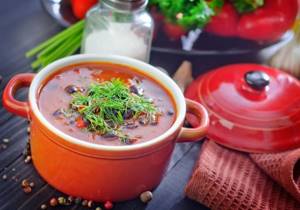
The diet does not change throughout the week. The main course is a stew made from beans, carrots and bell peppers (you can add onions if desired). Additional products: stewed vegetables, low-fat kefir. Meat and fish dishes are not included in the menu. It is recommended to drink a glass of water an hour before meals.
Recommended menu
- Breakfast - coffee or tea without sugar.
- Lunch: bean soup.
- Dinner - boiled beans with a side dish of stewed vegetables.
- Before going to bed - a glass of kefir.
Important recommendations! To maintain your weight loss results and not gain back the lost pounds, after completing the diet regimen, the transition to normal eating should be smooth. Meat and fish are allowed to be included in the diet no earlier than after 5 days. For at least 10 days, it is recommended to take food in small portions, increase calorie content gradually, avoid eating fatty, fried and sweet foods, and limit the amount of salt.
Comprehensive protein diet
This dietary program is quite gentle and easily tolerated. It is followed for 7 or 14 days; in one week you can lose 5 kg. According to the rules, the lunch and dinner menus must include legume dishes. It is also allowed to use:
- lean meat and fish;
- porridge;
- vegetables;
- fruits;
- berries;
- low-fat dairy products (including hard cheese);
- fresh fresh juices;
- unsweetened tea and coffee.

You should drink 1.5-2 liters of water per day. Meals are four times a day, the last meal is until 18:00.
Sample menu for the week
| Days | Breakfast options | High tea options | Lunch options | Dinner options |
| 1 | Kefir | Fruit salad | 100 g boiled beans with 1 tsp. vegetable oil, fresh vegetable oil | Tomato and cucumber salad, a couple of spoons of boiled lentils, fruit juice |
| 2 | 100 g cottage cheese, some raisins, yogurt | Apple or pear | A serving of bean soup | 100 g each of fish fillet and green peas, herbal tea |
| 3 | Rye bread toast with cheese, tea | Fruit salad | Salad of sauerkraut, boiled beans and onions, seasoned with 1 tsp. vegetable oil, coffee | Pea porridge, cucumber and green onion salad, seasoned with 1 tsp. vegetable oil, herbal drink |
| 4 | Slice of whole grain bread, piece of cheese, coffee | 2 kiwi or orange | A serving of bean soup, 2 slices of rye bread | 100 steamed meat, 50 g boiled cowpeas (asparagus beans), fruit juice |
| 5 | 100 g cottage cheese, a handful of raisins, yogurt | Grapefruit | A plate of vegetable broth, 200 g boiled lentils, a slice of rye bread | Stewed eggplant, a few spoons of boiled chickpeas, tea |
| 6 | 150 g boiled beans, orange juice | 4-5 drains | 100 g stewed beans, 50 g sauerkraut, tea | Stew of vegetables and any kind of legumes (no potatoes), a slice of whole grain bread, an herbal drink |
| 7 | 100 g cottage cheese, kefir | 3 apricots or peaches | Bean soup (about 250 ml), a slice of rye bread | Baked fish (150 g) with a side dish of 100 g boiled beans, tomato juice |
You can prepare dishes according to your own recipes, adhering to the requirements specified in the methodology, or use the cooking methods suggested below.

Rating of food delivery for weight loss
Delivery of food with calculated calorie content, ready-made diets. No more cooking and counting calories!
Go
Go
Recipes
Bean soup
This is a basic dish in many protein diets for weight loss.
Ingredients:
- 250 g green beans;
- carrot;
- bulb;
- 2 sweet peppers;
- parsley or celery;
- 1 tbsp. l. olive oil.
Soak dry grains overnight in cold water. Then replace the water with fresh water and cook the stew for about an hour over low heat. Add finely chopped carrots, onions, peppers, cook for another 15-20 minutes. Add herbs, oil and salt at the very end of cooking.
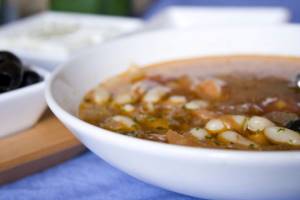
Country soup
Ingredients:
- white bean (you can use canned food) - 400 g;
- fresh tomatoes without skin - 400 g;
- onion - 1 pc.;
- pasta (preferably small) - 1/3 cup;
- oregano, basil or dill;
- vegetable broth - 1.5 l.
If dry grains are used, they should first be soaked in cold water for several hours, then boiled. The canned product does not require such preparation. Load broth and chopped vegetables into the pan, cook for about an hour, then add pasta, a tablespoon of vegetable oil, salt and keep on low heat for another 10 minutes. When serving, sprinkle with finely chopped herbs.

Bean puree
Pour dry bean seeds with cold water for half a day, then cook over low heat for 1.5-2 hours until they become soft. Rub through a sieve, add a couple of tablespoons of cream, salt, allspice, mix thoroughly. Serve the puree hot.
Lobio
Ingredients:
- young green bean fruits - 300-400 g;
- 1 carrot;
- 1 onion;
- tomato paste - 2 tbsp. l.;
- vegetable oil - 2 tbsp. l.
Cut the onion into rings and grate the carrots. Place all ingredients in a thick-walled saucepan or slow cooker, add half a glass of water, cook for about an hour.
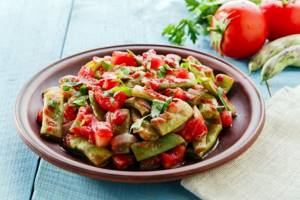
Bean dumplings
Grind the cooked beans in a blender or pass through a meat grinder. Add soaked bread, egg, finely chopped onion, and salt. Mix thoroughly, form small dumplings, roll them in breadcrumbs. Cook without fat - steam or in the oven. The ratio of ingredients is arbitrary.
Vegetable stew
The components of this tasty and nutritious vegetarian dish can include any seasonal vegetable crops:
- asparagus bean;
- bell pepper;
- tomatoes;
- broccoli, cabbage or Brussels sprouts;
- onion;
- carrot;
- sweet potato.
It is best to cook stew in a slow cooker. To do this, vegetables are washed, peeled and cut into small cubes (onion half rings). Pour a little water into the bottom of the multicooker container, add a couple of tablespoons of vegetable oil, then place the rest of the ingredients there. Cooking mode: “Stewing”. The stew can be served hot or cold.
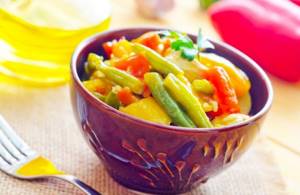
Salad "Hercules"
This low-calorie, but satisfying snack dish is prepared in a few minutes.
Ingredients:
- green beans (preferably milky ripe);
- red bell pepper;
- fresh herbs (dill, parsley, basil);
- low fat hard cheese.
Boil the grains, cut the peppers into cubes, grate the cheese on a coarse grater, chop the greens with a knife. Mix everything, put in a salad bowl, season with 10% sour cream or yogurt.
Hot salad
Soak chickpeas in water for a day and boil. Peel the eggplants, cut into cubes, cover with salted water for 10 minutes, then squeeze and bake in the oven. Combine eggplants, chickpeas, finely chopped green onions, dill or parsley. Lightly add salt and mix gently. Serve hot.

Bean broth
Acts as a bowel cleanser and promotes weight loss. To prepare a daily portion of the decoction, pour 2 tablespoons of green beans of milky ripeness with two glasses of boiling water, hold in a water bath for 15-20 minutes, then cool. Divide the drink into 4 parts and drink throughout the day.
Disadvantages of legumes and to whom they are contraindicated
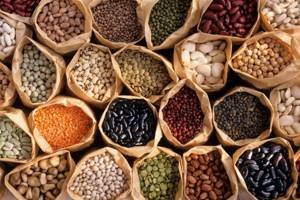
Not everyone can use legumes for weight loss. They contain proteins that are difficult to digest and take a long time to digest by the stomach, so this diet is not recommended for problems with the gastrointestinal tract. It is forbidden to add them to the menu and for diseases of the biliary tract.
In order for food to be absorbed and processed faster, it should be subjected to intensive and prolonged heat treatment. For those who are reluctant to cook or do not have time for this, losing weight on beans is not suitable. To cook peas, beans, and soybeans faster, it is recommended to pre-soak them in cold water.
The disadvantage of undercooked fruits can be attacks of flatulence. They also occur with excessive consumption of these foods. Small portions and plenty of drinking will help you avoid flatulence. As for raw use, they are eaten only in their unripe green form, green beans, green peas.
Legumes contain starch and also take a long time to cook. If you fill them with water a few hours before cooking, this will remove excess starch and reduce the cooking time. In addition, the less food is heat-treated, the more vitamins and minerals it retains. The ideal option in this case is a multicooker.
Among the variety of bean-based diets, the most effective are those in which animal fats are completely excluded from the diet. In other words, you cannot eat any meat; this can also be considered a disadvantage for those who cannot imagine their life without such a delicacy.
Therefore, a diet based on beans without meat is not suitable for meat eaters . But there is another option when the diet includes legumes, lean meat, and fish. But in any case, you will have to give up sweets and baked goods.
Contraindications
Not everyone can follow the bean diet for weight loss. Restrictions on its use are associated both with the composition of this vegetable crop and with the characteristics of its absorption.
- Due to the high content of substances in legume seeds that promote the crystallization of uric acid salts - purines - this diet is prohibited for diseases of the kidneys, liver, pancreas, uric acid diathesis, urolithiasis, gout, arthritis, rheumatism.
- The presence of a sufficiently large amount of phytates (the so-called phytic acid compounds) reduces the bioavailability of microelements, including iron. This makes legumes a forbidden food for certain blood diseases.
- This type of diet is not recommended for weight loss for older people, as well as for diseases of the digestive system. The reason is the difficult digestibility of legume fiber, its irritating effect on the mucous membrane (the result is increased gas formation, flatulence, and stool disorders).
Is it possible to eat legumes for weight loss?
All representatives of legumes are distinguished by their rich composition:
- vitamins PP, C, K, A, E and almost the entire B line;
- potassium, phosphorus, magnesium;
- iron, manganese, zinc;
- easily digestible amino acids;
- pectins, fiber;
- lysine, phytates.

All of these elements take an active part in metabolic processes and, if they are sufficiently supplied to the body, metabolism accelerates, which affects the burning of fat cells. Benefits of legumes for weight loss:
- Toxins, waste and excess fluid are removed from the body - swelling disappears, complexion changes for the better;
- the intestines are cleared of accumulated feces, its walls begin to absorb only useful substances from already digested food;
- There is a weak choleretic effect - the digestion process improves, blood sugar levels normalize and stabilize, and “harmful” cholesterol is eliminated.
Thanks to the high content of B vitamins, all representatives of legumes improve brain function (increase concentration, make memory stronger) and stabilize the psycho-emotional background - stress becomes rare, depressive states go away, the desire to “eat up” problems and troubles disappears.

Legumes are considered an excellent choice for weight loss because of their low calorie content. And doctors specifically highlight the ability of such products to provide a film on the gastric mucosa, which prevents the rapid absorption of large amounts of fats and carbohydrates. This leads to the complete transformation of the latter into glucose, which ensures a long-lasting feeling of satiety.
The only harmful properties that can be identified are increased gas formation - this is a “side effect” when consuming any representatives of legumes. But you can make it less intense with the help of fennel or mint - they are consumed simultaneously with “harmful” foods.
We recommend reading about beans for weight loss. You will learn about the nutritional value and calorie content of beans, their types and choices for weight loss, recipes for dietary dishes, and a bean diet. And here is more information about lentils for weight loss.
Reviews and results of losing weight
Anna, 32 years old
Since childhood, I have loved beans, peas, and chickpeas. Therefore, when I decided to lose a little weight, the choice of diet was obvious. Dishes made from legumes are tasty and satisfying, so I didn’t experience any discomfort. The only “inconvenience” was that I had to give up sweets, and I have a sweet tooth. In two weeks I managed to lose almost 6 kg of weight.
Valentina, 28 years old
I was on this diet for weight loss for only 3 days, and I couldn’t stand it anymore. On the very first day, problems with gases began: the stomach was swollen like a drum, there was a constant heaviness in the stomach and intestines. Further - more, intestinal colic and constipation appeared. I did not notice any weight loss. I have no complaints against the authors of legume diets; they honestly warn about the possible consequences. Personally, I'll just have to find a more suitable method for losing weight.
Olga, 25 years old
A comprehensive protein diet combined with the gym helped me lose almost 5 kg in two weeks. True, the annotation stated the figure of 7 kg per week, but I consider my result to be very good, considering that I did not experience severe hunger or loss of strength. Now I try to eat less simple carbohydrates in order to maintain the achieved weight. It’s a bit difficult, but overall it works.
The bean diet is great for weight loss and satiation.
Experts in the field of dietetics and healthy nutrition have created the bean diet as a safe and effective way to combat excess weight. It really pays off, because in 14 days it allows you to lose 3-5 kg. Of course, there are faster and more efficient power systems. However, it is this diet that makes it possible to lose weight and adhere to proper nutrition at the same time. Surely many, after reading the name, will decide that to lose weight they will have to eat only beans. It's not like that at all. In fact, the diet on this diet has an enviable variety. If you supplement it with daily physical activity, good results will please you even faster.
What will you need to eat on such a diet? As they say, not just peas. The list of legumes, fortunately, is quite extensive. To prepare dietary dishes, you can safely use soybeans, beans, lentils, chickpeas, cocoa beans and the already mentioned peas.


